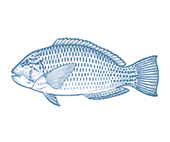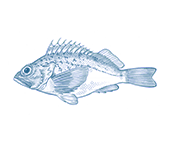




- Eat Less
Wild Caught
Region:
QLD
- Sea mullet are caught in commercial beach haul, gillnet and tunnel net fisheries in coastal waters, estuaries and river mouths in QLD, NSW, and WA waters.
- A recent scientific assessment suggests that the QLD sea mullet population is slightly below a sustainable level and has been declining in recent years.
- Most QLD sea mullet catch is from beach haul net and tunnel net fishing methods, which have low-negligible impacts on vulnerable or endangered species and seafloor habitats.
- The Moreton Bay and Great Sandy Straits marine parks provide a degree of protection for impacted species and habitats.
- The fishery observer program in QLD was cancelled in 2012, meaning there is no independent record of the impact of the fishery on threatened species. Observation of the fishery is considered essential to the management of a sustainable fishery.
- Fishers are generally present at the nets during fishing, which means any endangered wildlife caught can be released alive.




Mullets have juicy, slightly oily flesh with a medium to strong flavour. For the best results, the fish should be very fresh and well handled, showing clear eyes, firm flesh, bright red gills and no fishy smell. Mullet goes incredibly well cooked on the BBQ or hot smoked, the slight oiliness ensures the fish remains moist. Smoky flavours compliment it well. Accompany mullet with Mediterranean flavours such as tomato, olive and basil. Whole mullet can also be roast in a hot oven with similar flavours – the moist flesh will flake from the bones with ease.
- QLD East Coast Inshore Fishery (1,427t in 2021, 1,218t in 2020)
Sea mullet are found throughout the coastal waters of tropical, subtropical and temperate zones of all seas. They are found around sandy, sea grass, and mangrove habitats. They are caught in commercial fisheries in QLD, NSW and WA.
Sea mullet are mostly caught in beach haul and tunnel nets, and to a lesser extent in gillnets, in QLD.
A scientific assessment of the Sea mullet population and modernised management arrangements for the fishery has recently been introduced, which is welcome. The collaborative nature of the assessment between QLD and NSW managers, which catch the same Sea mullet population is a welcome innovation. The assessment shows that sea mullet populations have been declining to slightly below a sustainable level. While current levels of fishing pressure should deliver some recovery, significant catch cuts will be required to rebuild the stock to truly sustainable levels in line with management targets.
The beach haul and tunnel net methods used to catch most Sea mullet in QLD facilitate the release of any unwanted catch with high survival rates, making these fishing methods a relatively low impact and sustainable approach. They are also deployed over sandy or muddy habitats which are resilient to fishing disturbance.
Interactions with turtles have been recorded in fishing operations using gillnets, although it is not clear from fishery reports how many interactions or turtle deaths have occurred. Interactions with dugongs and protected species of shark are also likely in these coastal fisheries, but there is a lack of current information on bycatch across the entire geographical range of the fishery. The small scale of most of the fishing operations and that fishers are present at the nets during fishing means endangered wildlife can be released alive.
The fishery largely operates within the Moreton Bay and Great Sandy Straits marine parks. These offer a significant degree of additional protection for targeted and secondary species, as well as threatened and vulnerable bycatch species.
Independent fishery observer programs are an important method of verifying protected species interactions. Unfortunately the QLD Government closed the observer program for all QLD managed fisheries in 2012. Since that time there remains no independent on-water monitoring of the fishery’s impact. Independent fishery observer programs are an important method of verifying protected species interactions. Unfortunately the QLD Government closed the observer program for all QLD managed fisheries in 2012. Since that time there remains no independent on-water monitoring of the fishery’s impact. As this means there is no reliable record of actual protected species interactions over time, the ecological impacts of the fishery cannot be measured or managed. However, the QLD sea mullet gillnet fishery is considered to pose a moderate risk to a range of threatened and vulnerable species. The low bycatch of beach haul and tunnel net fishing for sea mullet suggest a low risk to those species, despite a lack of reliable data.


